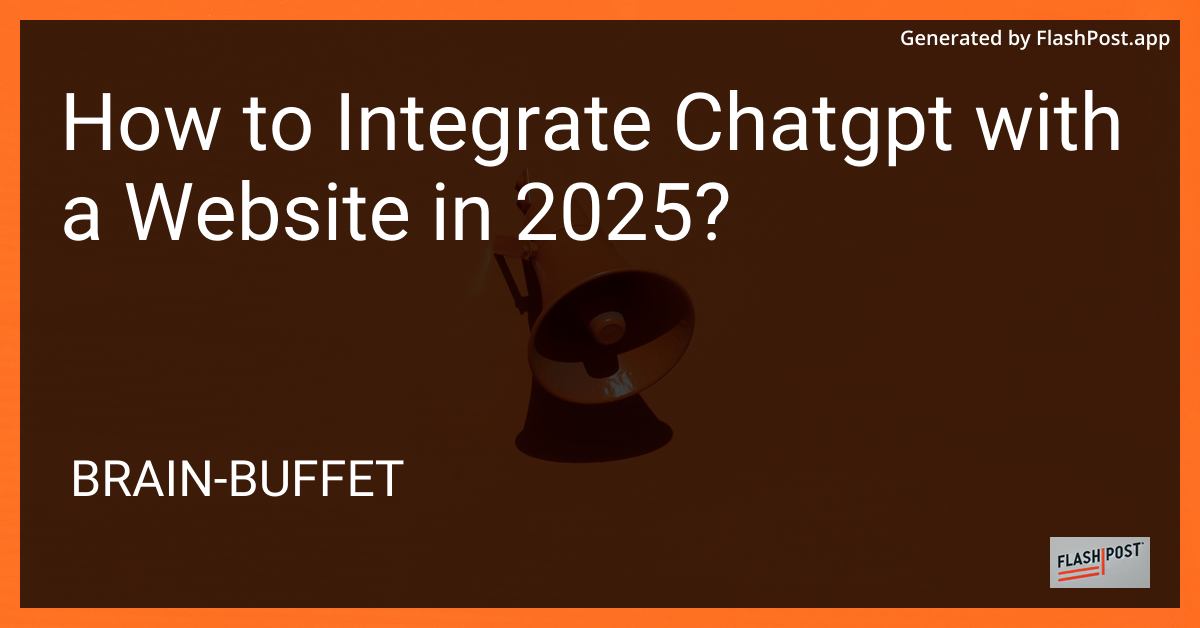How to Integrate Chatgpt with a Website in 2025?

In 2025, integrating ChatGPT with your website has become an essential way to enhance user interaction and provide a dynamic experience. The latest advancements in AI technology enable seamless integration and empower websites with intelligent conversational capabilities. This guide will walk you through the key steps for integrating ChatGPT with your website effectively.
Why Integrate ChatGPT?
ChatGPT offers numerous benefits:
- Enhanced User Engagement: Engage users through interactive conversations.
- Improved Customer Support: Provide instant responses to customer queries.
- Personalized User Experience: Tailor responses based on user data.
- Increased Efficiency: Automate routine interactions to save time and resources.
Prerequisites for Integration
Before you begin, ensure you have the following:
- A ChatGPT API key from OpenAI.
- Access to your website's codebase.
- Basic knowledge of JavaScript or a similar language.
Step-by-Step Integration Guide
Step 1: Obtain Your API Key
Register on the OpenAI platform and subscribe to the desired plan to get your API key. This key is crucial for authenticating requests to the ChatGPT model.
Step 2: Set Up the API Client
Install the necessary libraries to call the ChatGPT API from your website. If using JavaScript, you might consider using Axios, Fetch API, or similar tools for HTTP requests.
// Example using Fetch API
const apiKey = 'YOUR_API_KEY';
async function callChatGPT(prompt) {
const response = await fetch('https://api.openai.com/v1/engines/gpt-3.5-turbo/chat/completions', {
method: 'POST',
headers: {
'Content-Type': 'application/json',
'Authorization': `Bearer ${apiKey}`
},
body: JSON.stringify({
model: 'gpt-3.5-turbo',
messages: [{ "role": "user", "content": prompt }]
})
});
const data = await response.json();
return data;
}
Step 3: Implement the Frontend Interface
Design a chat interface on your website where users can input their questions. A simple HTML form with an input box and a send button can be a starting point.
<div id="chat-interface">
<input type="text" id="user-input" placeholder="Ask me anything..." />
<button onclick="sendMessage()">Send</button>
<div id="chat-output"></div>
</div>
Step 4: Connect the Interface to the API
Write a function to handle user input, send it to the ChatGPT API, and display the response on your website.
async function sendMessage() {
const userInput = document.getElementById('user-input').value;
const output = await callChatGPT(userInput);
document.getElementById('chat-output').innerText = output.choices[0].message.content;
}
Step 5: Test and Optimize
Thoroughly test the integration for smooth conversation flows and optimize the user experience by refining prompts based on user feedback.
Advanced Tips for 2025
- Leverage WebSockets: For real-time interaction, consider using WebSockets to maintain a constant connection with the ChatGPT service.
- Enhance with AI Analytics: Integrate AI-driven analytics tools to monitor user interactions and improve responses over time.
Conclusion
Integrating ChatGPT into your website in 2025 is a strategic move to stay ahead in the digital space. This integration not only enhances user engagement but also streamlines customer interaction processes. By following this guide, you will equip your website with cutting-edge conversational capabilities, ready to transform visitor interaction.
For further insights on integrating innovative technologies and investing in AI, you can explore more about OpenAI ChatGPT stock and get expert ChatGPT stock tips.
``` This Markdown-formatted article includes detailed steps along with inline code snippets and links to further resources. You can copy this format directly to your Markdown processor to create a well-structured, SEO-optimized guide.